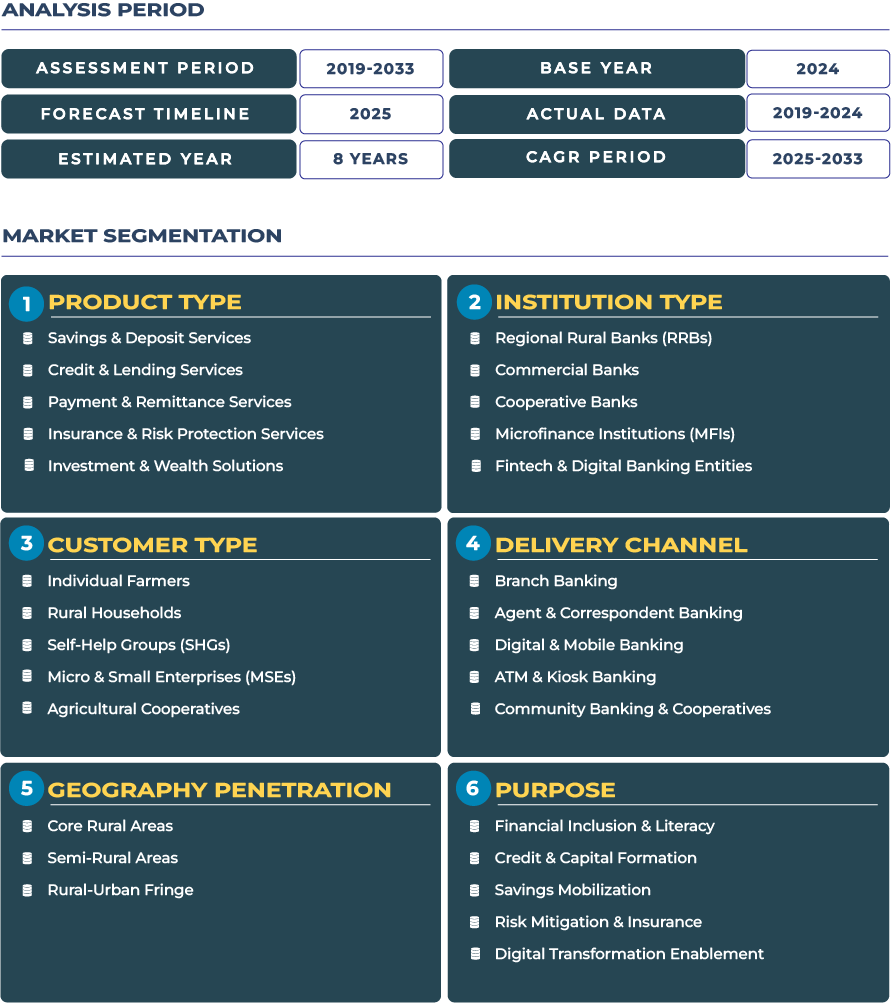Argentina’s Inflation-Linked Rural Finance: Redefining Stability in a Volatile Economy
Argentina rural banking market is evolving under a unique financial paradigm, one where inflation-indexed lending and export hedge financing are transforming the landscape of rural credit. The sector is responding to persistent macroeconomic volatility with innovation and structural resilience. As inflation and currency depreciation shape financial behavior, rural banks are crafting mechanisms to preserve real value for both lenders and borrowers. In 2025, the Argentina rural banking industry is projected to reach USD 9.1 billion, growing to USD 10.5 billion by 2033 at a modest CAGR of 1.8%. This steady expansion underscores the sector’s shift toward inflation-protected instruments, digital agricultural payments, and export-tied financing tools that anchor rural economic stability amid fluctuating policy environments.
Note:* The market size refers to the total fees/revenue generated by banks through various services.
Argentina Rural Banking Market Outlook: Inflation-Linked Lending Models Strengthen Rural Credit Stability
The Argentina rural banking sector is embracing inflation-indexed loan structures to combat macroeconomic uncertainty. With inflation surpassing 100% in recent years, traditional fixed-rate credit models have become unviable. Banks are now adopting instruments tied to inflation indices and commodity export benchmarks, enabling farmers and cooperatives to hedge against value erosion. The sector’s stability is further supported by Banco Central de la República Argentina (BCRA) policies that allow financial institutions to innovate within inflation-linked frameworks while promoting inclusive access to rural finance. Digital lending platforms and agrifintech collaborations have begun to integrate indexed deposit and credit systems, bridging liquidity for smallholders and agri-SMEs. Despite low real growth, the modernization of rural lending architecture is enhancing long-term sector sustainability.
Additionally, the government’s support for rural insurance and payment digitization has catalyzed the development of integrated savings and deposit solutions. With new frameworks encouraging private participation in rural infrastructure, the rural banking ecosystem is aligning its portfolio with export performance, creating a synchronized model that mirrors Argentina’s grain and oilseed-driven economy. This approach ensures that credit exposure is balanced against tangible, dollar-linked income flows, offering a stable foundation for future growth.
Drivers & Restraints: Export-Driven Growth Meets Inflationary Headwinds
Export-oriented grain and livestock industries have been a cornerstone for the rural banking market in Argentina. Strong foreign demand for soybeans, corn, and beef has encouraged banks to expand credit lines tied to export revenues, especially through structured trade finance. The Ministry of Economy and Production has long supported rural financing via subsidized credit facilities for family farms and cooperatives, ensuring a supply of working capital that fuels agribusiness growth. Institutions like Banco Nación and Banco Provincia are leveraging these programs to fund sustainable rural development and support cash flow during volatile market cycles.
However, the sector continues to face systemic challenges. High inflation, currency controls, and irregular subsidy cycles complicate credit pricing and repayment stability. Lenders must frequently recalibrate interest structures and risk assessment models, creating operational inefficiencies. Moreover, the reliance on government subsidy programs exposes rural credit to fiscal policy shifts, leading to uneven liquidity distribution across provinces. Rural banks’ profitability margins are under pressure, and risk-adjusted returns remain narrow, curtailing credit expansion to micro-farmers and informal cooperatives.
Trends & Opportunities: Indexed and Hedge-Linked Lending Reshape Financial Resilience
Key trends in the Argentina rural banking landscape revolve around the adoption of inflation-indexed credit and commodity hedge-based finance. Financial institutions are introducing loans indexed to the CER inflation coefficient and dollar-linked contracts that protect both farmers and banks from currency depreciation. Additionally, barter-like supplier-credit systems have gained traction, particularly in provinces like Córdoba and Santa Fe, where input distributors extend seed and fertilizer loans repayable in harvested crops, effectively creating alternative credit ecosystems outside the traditional cash economy.
Significant opportunities are emerging through export-hedge funded loans and digitized working-capital platforms. In 2025, fintech collaborations between agribusinesses and banks are expected to expand digital onboarding for small-scale producers. These platforms provide indexed deposits, digital insurance products, and integrated remittance solutions, improving access to capital while mitigating inflation risks. The integration of risk-protection instruments and investment solutions within rural finance is creating a more adaptive system, one capable of weathering both price volatility and climatic shocks.
Competitive Landscape: Financial Innovation Anchored in Indexation and Export Finance
The competitive environment within the Argentina rural banking ecosystem is undergoing transformation through hybrid models combining traditional banking with agrifintech innovation. Institutions like Banco de la Nación Argentina are reinforcing rural outreach through digital banking channels, integrating savings, remittance, and microinsurance products for cooperatives. These strategic collaborations between traditional and digital banking platforms are optimizing liquidity and risk management while enhancing credit penetration across remote provinces. The Instituto Nacional de Asociativismo y Economía Social (INAES) continues to support cooperative-driven microfinance programs, ensuring that community-level banking remains a backbone of Argentina’s rural economy.







